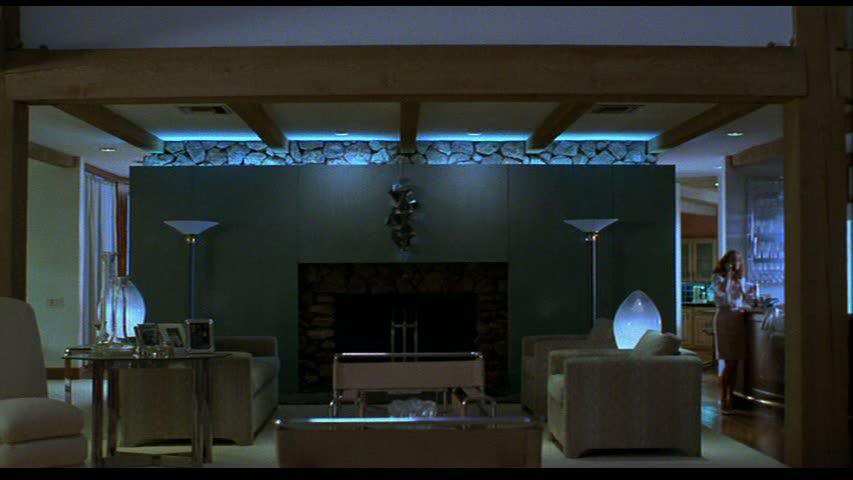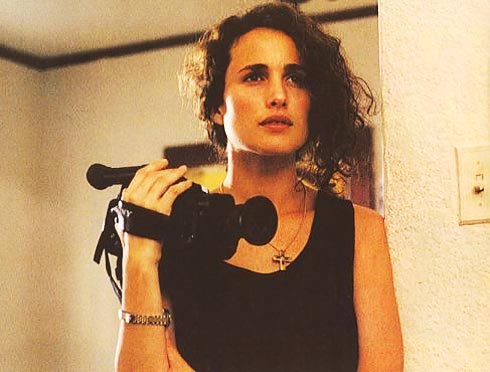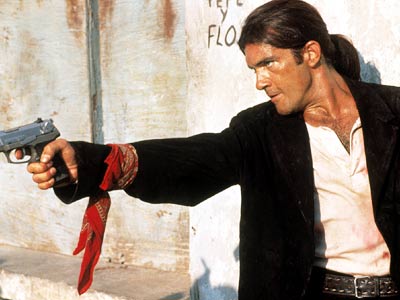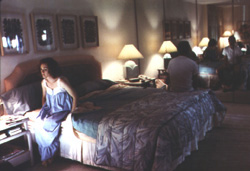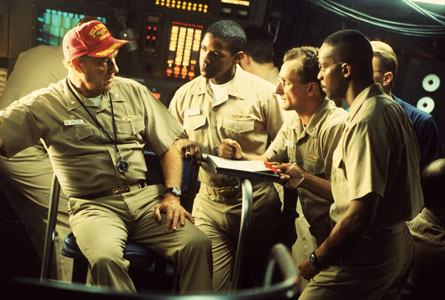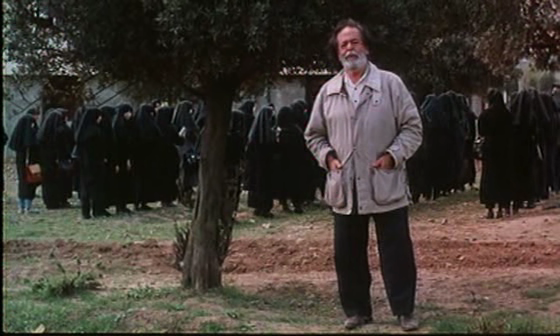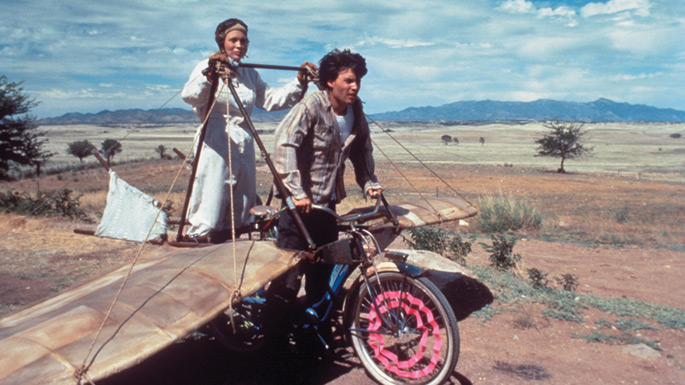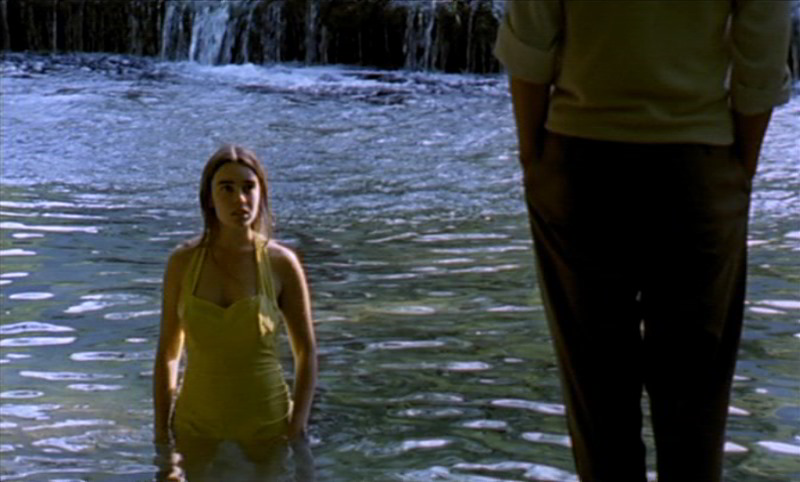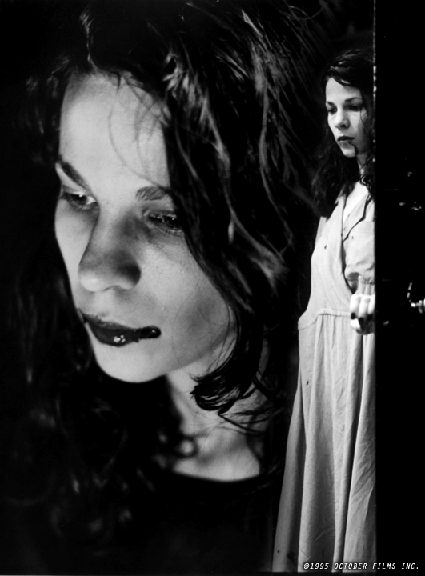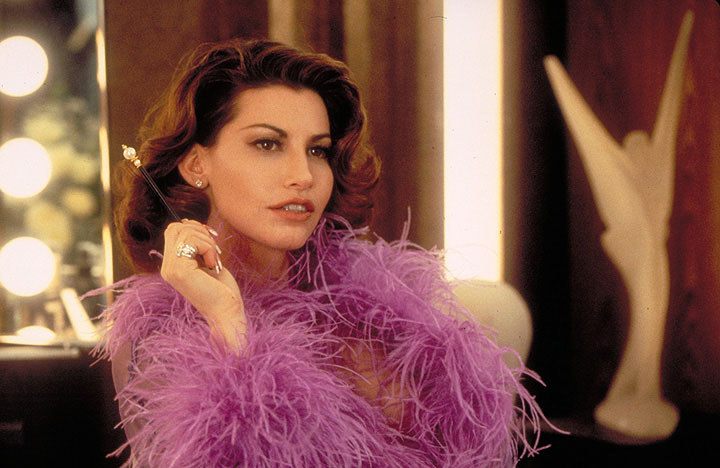A kind of ten-best meditation for Artforum, December 1995 (vol. 34, issue 4), that anticipates some of my arguments in my subsequent book Movie Wars: How Hollywood and the Media Limit What Films We Can See. Incidentally, I’ve since then come to value Showgirls (and, more generally, Paul Verhoeven) far more than I did 25 years ago, politically and otherwise. — J.R.
In October I compiled three lists for my own schizoid edification. The first consisted of the 50 best films I had seen this year at festivals in Berlin, Cannes, Locarno, and Toronto and as a member of the New York Film Festival selection committee (which entailed a screening of 100 more films in August). The second was my impression of what comprised the 50 most discussed films released in the United States this year; my third list was a selection of what I considered the 20 most important releases, whether they were widely discussed or not. Only one feature appears on all three lists — Todd Haynes’ Safe.
One reason for the lack of overlap between my three lists is that, unless it’s a big-studio product, a film usually takes at least a year to open commercially in the United States after its premiere at festivals, ensuring that we remain something of a last-stop backwater when it comes to most non-Hollywood movies. And a significant contributing factor to this state of affairs is the eye of the needle represented by reviews in The New York Times, which, in the minds of most distributors, all films must pass through before they can make it in markets outside New York. For those who wonder why the New York Film Festival showcases only 20-odd programs compared with the hundreds found at other major festivals, I suspect that the capacities of the Times have something (if not everything) to do with this. Similar forces are at work in the launchings given to American independent features at Sundance — an event partially sponsored (albeit quietly) by the Times, thereby enabling it to offer its disinterested, “in-depth” daily coverage of the annual sellouts of independent filmmakers to studio agents in a ski-resort setting while discreetly fueling the same process from the wings — a packaging combo that offers a neat corporate alternative to recently gutted NEA funding.
Ever since sex, lies, and videotape six years ago, a central part of the spurious Sundance jive is the notion that independents can only triumph as artists if they land big-studio contracts. A simple look at the mainstream debuts of Robert Rodriguez and Kevin Smith (Desperado and Mallrats, respectively — not to mention the horrific forthcoming Four Rooms (by four Sundance alumnae) should disabuse most people of this crippling myth, but considering how much vested interest the studios have in its perpetuation, the same homilies get trotted out by obliging journalists in spite of all the contrary evidence. (How many even noticed that Rodriguez’s El Mariachi was a tragic parable about losing one’s status as an independent, working-class folk artist, or that Smith’s Clerks was in part a comedy about proletarian revenge? Take away their class trimmings and you get the dispiriting second features of both filmmakers.)
On the other hand, Todd Haynes has clearly taken a major step forward despite continuing to work without studio backing. Working with a poetry of absence evocative of both Chantal Akerman and Michelangelo Antonioni in the upscale suburban reaches of the San Fernando Valley, where overstuffed living rooms and manicured gardens are made to seem as vast and as hollow as city railway terminals, and the sound track is no less instrumental in creating a sharp sense of distance and displacement, Haynes creates a glowering atmosphere of nameless dread that, along with the heroine played by Julianne Moore, most reviewers have felt obliged to name — generally calling it “environmental illness” — if only to assign this movie a coherent narrative curve. Fortunately, even with its false-happy ending, the mystery goes on being mysterious, and potentially lethal to boot. Unlike Exotica — Atom Egoyan’s cuddly and pornographic fantasy about incest and erotic loss, Canadian to the core in its hothouse claustrophobia — Safe didn’t make it into many malls, but it haunted one’s experiences of those places just the same.
Two film reviews from this year epitomize the myopic effect of self-fulfilling business prophecies on the critical apparatus of film culture. In USA Today, a review of Crimson Tide noted that, even though the movie was an all-too-familiar rehash of cold war thrillers, there was obviously a brain behind it (duly noted as that of Quentin Tarantino, who did an uncredited polish of the script) because of all the Star Trek references in the dialogue. The second fragment comes from the Times‘ review of Larry Clark’s Kids and was quoted in many of the origina ads, which is where I encountered it: “A wake-up call to the world.”
Consider the respective definitions of “brain” and “world” implied here. I especially treasure the ringing clarity of “a wake-up call to the world”; it draws a firm line in the sand and declares that rice paddy workers everywhere — or at least those with phones — should lay down their hoes and stop evading the problems of white Manhattan teenagers. And in case anyone’s still wondering how a slightly better-than-average, sour, and cautionary youth-exploitation item could galvanize the same media that studiously ignored most of the best movies released this year — to the extent that one major news weekly could inform its first-string reviewer in advance that Kids was one of the only movies at Cannes worthy of any coverage — at least four interlocking factors come into play: the hysteria of American puritanism, a distributor (Miramax) that often knows precisely how to milk such hysteria in the name of esthetics (though it was less lucky with Priest, which it whimsically planned to open on Good Friday), a “special” Sundance preview held at midnight to foster a proper journalistic sense of melodrama, and a paper like the Times already primed to go for such middle-class bait.
Though it’s seldom noted, the degree to which institutions like the Times, Miramax, and Sundance set our current critical agendas (including our canons) and crowd out others is hard to ignore. All three institutions had a lot to do with the launching of Tarantino as well as Kids, not to mention the even less interesting Brothers McMullen, which apparently thrilled some viewers because it reminded them of Woody Allen (another Times favorite distributed by Miramax, though not a Sundance regular). The fact that Miramax dwarfs all competitors in terms of its acquisitions power and ad budgets — spending as much money, for instance, on hyping Pulp Fiction as on producing it (which undermines part of that movie’s credibility as a grassroots cult sensation) — might be relatively innocuous if the company didn’t dump or revise so many of its best pictures, including Richard Williams’ Arabian Knight, Abbas Kiarostami’s Through the Olive Trees, and Charles Burnett’s The Glass Shield. The first two — an eclectic animated feature of compulsive two-dimensionality worked on as a labor of love since the ’60s, and the first Iranian feature ever distributed in the United States, made by the greatest of all Iranian filmmakers, respectively — were virtually shot down at the start, implying a certain company bias against Persian miniatures. After purchasing and sloppily completing Arabian Knight without any input from Williams, Miramax opened it with silly ads comparing it to Aladdin and no press shows at all. The Kiarostami film — while perhaps not as interesting a film as his Homework, Close Up, and And Life Goes On . . . (which also deal with the potent theme of interchanges between filmmakers and ordinary people), still arguably superior to everything else on Miramax’s recent slate and a superb introduction to his cosmic view of landscape and witty sense of character — was similarly treated as if it were a worthless embarrassment, and it was scarcely a surprise to find most of the mainstream press passively agreeing that it should be ignored. (When the Music Box, a prominent Chicago art house, had the temerity to try booking Through the Olive Trees anyway, it was summarily rebuffed by Miramax.)
No less a case in point were the parallel treatments accorded by Miramax to Paul Auster and Wayne Wang’s Smoke, with its flattering view of good-hearted middle-class whites saving the souls of poor blacks in Brooklyn, and The Glass Shield, which sorrowfully and persuasively demonstrates the price to be paid when a black rookie cop in L.A., desperate for acceptance in an all-white precinct, perjures another black man. Smoke was treated as a gilt-edged art house item, earmarked for “thoughtful” white patrons, whereas the second was test-marketed with black teenagers in the Bronx, whose predictable complaints obligle Burnett to come up with a more “upbeat” ending to get his picture released. Undoubtedly flawed in its top-heavy plot in a way that Smoke (or Burnett’s wonderful subsequent short When It Rains) is not, The Glass Shield is still honest about the way we live and maintains an integrity of purpose that makes Smoke register at best like a seductive lie. Compare, for instance, Lori Petty’s fresh and offbeat performance as a Jewish cop in Shield with the work of such normally gifted players as Stockard Channing and Ashley Judd in Smoke. (Petty also brought distinction to Rachel Talalay’s goofy and neglected Tank Girl.) Indeed, if Smoke, with its soupcon of plantation-house paternalism, had been test-marketed like Shield with the same ghetto teenagers, they might have conceivably torn the screen off the wall.
The arrogant expedience of assuming that African and Taiwanese cinema, for example, are negligible if they are ignored by Miramax and other big distributors is another creepy symptom of our insulated isolationism. Such impulses — and today’s movie culture is full of them — are ultimately reducible to the Reaganite economic philosophy of exhausting existing markets without investing in any potential future ones, yielding the self-protective gestures of critics periodically announcing the “collapse” of European cinema and happily accepting the limitations of distributors as reliable indices of the state of world cinema. What such provincialism has already fostered in American movies is a certain stroking of the spectator’s alleged savvy and hipness in recognizing certain TV touchstones — providing much of the basis for last year’s Pulp Fiction, Natural Born Killers, and Forrest Gump, and this year’s The Brady Bunch Movie and Crimson Tide.
Of course, it’s a truism that films with reduced promotional budgets, regardless of their quality, tend to get marginalized. But the capacity of these films to reach their intended audiences anyway is greater than one might initially suspect. Tony Gatlif’s Latcho Drom, a formally and politically radical Gypsy musical, confounding the standard industry wisdom that the genre is a dead form, attracted short shrift from most of the press but enough word of mouth to spark several return engagements. Like Jacques Tati’s equally overlooked Parade of 1974, the movie boldly breaks down the usual distinctions between documentary and fiction, between performer and audience, and even between finishing a given sequence and starting another. Mark Malone’s Bulletproof Heart, a virtual inversion of Pulp Fiction that puts the pain back into hitman murder while sustaining a related form of play with narrative form and actors (Anthony LaPaglia, Mimi Rogers, Peter Boyle, and Matt Craven), was similarly rebuffed in the mainstream press but enjoyed by many who sought it out. Interestingly enough, Bosnian director Emir Kusturica’s Arizona Dream and French director André Téchiné’s Wild Reeds both benefited from opening outside New York, arriving in Manhattan only after garnering plenty of raves elsewhere. The first, which Warner Communications prematurely shelved back in 1993, enlists Johnny Depp, Jerry Lewis, Vincent Gallo, Lili Taylor, and Faye Dunaway in a black comedy about American dreams and two terminally dysfunctional families; the film is a good illustration that many European filmmakers who use this country as a site for fantasies at least know they’re dreaming. Wild Reeds, set in southwest France in 1962, shows another European — Téchiné, peaking in his 12th feature — looking back with honesty, urgency, and warmth at aspects of his own adolescence.
Many of my other favorite releases of the year were mixed bags, but there were still plenty of reasons for seeing them. The Addiction wedded Abel Ferrara’s beautifully intense direction in nocturnal black and white with one of the dumbest scripts ever written; Clint Eastwood’s The Bridges of Madison County worked a few aural and visual wonders with its own dubious literary source. Yim Ho carved out a crime melodrama, The Day tbe Sun Turned Cold, that was worthy of John Frankenheimer in the ’60s, and, with Germany Year 90 Nine Zero, Jean-Luc Godard went on being Jean-Luc Godard (for whom the disassembly of the Berlin Wall coincided tragically with the last days of Lemmy Caution). From a plastic arts perspective, the most notable filmic achievements included Jon Jost’s monumental diptych compositions in The Bed You Sleep In, most of them corresponding to various thematic duplicities (and resulting alienations); the inspired art direction of Bob Balaban’s The Last Good Time (and the sheer life-sculptured earthiness of Lionel Stander in his last screen performance); the exemplary analysis of an artist’s relation to his work in Terry Zwigoff’s Crumb; the extended historical footnotes to a single jazz photograph (taken in 1958 by Art Kane) in Jean Bach’s A Great Day in Harlem; some eerie work with subjective camera and color filters in Steven Soderbergh’s The Underneath; and the Stan Brakhage-like credits sequence and the designer-vomit interiors in David Fincher’s Seven. And at least there was the inspiring implication of the commercial flop of Paul Verhoeven and Joe Eszterhas’ blowsy Showgirls: that you can underestimate the taste of the American public, especially when self-loathing is the main bill of fare.

